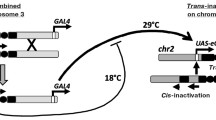Abstract
The entire 1731 retrotransposon of Drosophila melanogaster, tagged with the E. coli lac Z gene inserted in its gag sequence, was injected into oocytes and fertilized eggs of the urodele amphibian Pleurodeles waltl. Expression of the reporter gene indicated that the 1731 promoter (its 5′LTR) is active in the embryos and not in the oocytes. It appeared that this element is regulated as amphibian genes are at the beginning of the development, i.e. that expression was detected after the mid blastula stage and maintained up to four or five days after injection. Another construction associating the modified 1731 promoter with the CAT gene is also expressed in Pleurodeles embryos during the same period of development. This indicated that the 1731 promoter issued from a Drosophila species is activated as promoting sequences of amphibian zygotic genes are, suggesting that in the case of horizontal transfer, 1731 can be expressed into vertebrate organisms.
Similar content being viewed by others
References
Amman, E., B. Ochs & K.J. Abel, 1988. Tightly regulated tae promoter vectors useful for the expression of unfused and fused proteins in Escherichia coli. Gene 69: 301–315.
Barth, L.G. & L.J. Barth, 1959. Differentiation of cells of the Rana pipiens gastrula in unconditioned medium. J. Embryol. Exp. Morph. 7: 210–222.
Becker, J., J.L. Becker & M. Best-Belpomme, 1990. Characterization and purification of DNA-RNA complexes related with 1731 and copia-like transposable elements in a Drosophila cell line. Cell. Mol. Biol. 169: 1178–1184.
Becker, J., D. Micard, B. Dastugue & M. Best-Belpomme, 1991. Ecdysterone decreases the transcription level of the retrotransposons 1731 and 412 in a Drosophila cell line. Cell. Mol. Biol. 37: 41–49.
Champion, S., C. Maisonhaute, M.H. Kim & M. Best-Belpomme, 1992. Characterization of the reverse transcriptase of 1731, a Drosophila melanogaster retrotransposon. Eur. J. Biochem. 209: 523–531.
Echalier, G., 1989. Drosophila retrotransposons: interactions with genome. Advances in Virus Res. 36: 33–105.
Finnegan, D.J. & D.H. Fawcett, 1986. Transposable elements in Drosophila melanogaster. Oxford Surveys in Eukaryotic gene 3: 1–62.
Flavell, A.J., 1992. Tyl-copia group retrotransposons and the evolution of retroelements in the eukaryotes. Genetica 86: 203–214.
Fourcade-Peronnet, F., L. d'Auriol, J. Becker, F. Galibert & M. Best-Belpomme, 1988. Primary structure and functional organization of Drosophila 1731 retrotransposon. Nucleic Acids Res 16: 6113–6125.
Grandbastien, M.A., 1992. Retroelements in higher plants. Trends in Genetics 8: 103–108.
Gorman, C.M., L.F. Moffat & B.H. Howard, 1982. Recombinant genomes which express chloramphenicol acetyltransferase in mammalian cells. Mol. Cell Biol. 2: 1044–1051.
Kuff, E.L. & K.K. Lueders, 1988. The intracisternal A-particle gene family: structure and functional aspect. Advances in Cancer Res. 51: 183–276.
Lambert, M.E., J.F. McDonald & I.B. Weinstein, eds., 1988. Eukaryotic transposable elements as mutagenic agents. Cold Spring Harbor Laboratory, USA.
Lin, W.C. & L.A. Culp, 1991. Selectable plasmid vectors with alternative and ultrasensitive histochemical marker genes. Biotechniques 11: 344–351.
McDonald, J.F., 1990. Macroevolution and retroviral elements. Bioscience 40: 183–191.
Newport, J.W. & M.W. Kirschner, 1982a. A major developmental transition in early Xenopus embryos: I. Characterization and timing of cellular changes at the mid-blastula stage. Cell 30: 675–686.
Newport, J.W. & M.W. Kirschner, 1982b. A major developmental transition in early Xenopus embryos: II. Control of the onset of transcription. Cell 30: 687–696.
Ousenek, N., G.T. Williams, R.I. Morimoto & J.J. Heikkila, 1990. Cis-acting sequences and trans-acting factors required for constitutive expression of a microinjected Hsp70 gene after the mid-blastula transition of Xenopus laevis embryogenesis. Dev. gene 11: 97–109.
Petonnet, F., J.L. Becker, J. Becker, L. d'Auriol, F. Galibert & M. Best-Belpomme, 1986. A new retrotransposon with hormone regulated expression. Nucleic Acids Res. 14: 9017–9033.
Pierce, R.J., C. Aimar, J.M. Balloul, M. Delarue, C. Grausz, D. Verwaerde & A. Capron, 1985. Translation of Schistosoma mansoni in Xenopus oocytes microinjected with mRNA from adult worms. Mol. Biochem. parasitol. 15: 171–188.
Rusconi, S. & W. Schnaffner, 1981. Transformation of frog embryos with a rabbit β-globin gene. Proc. Natl. Acad. Sci. USA 78: 5051–5055.
Sambrook, J., E.F. Fritsch & T. Maniatis, 1989. Molecular cloning: a laboratory manual. 2nd ed. Cold Spring Harbor Press. New-York, USA.
Signoret, J. & J. Lefresne, 1971. Contribution à l'étude de la segmentation de l'oeuf d'axolotl: I. definition de la transition blastuléenne. Ann Embryol Morphol 4: 113–123.
Slack, J.M.W. & J. Forman, 1980. An interaction between dorsal and ventral regions of the marginal zone in early amphibian embryos. J. Embryol. Exp. Morph. 56: 283–299.
Temin, H.M., 1980. Origin of retroviruses from cellular movable genetic elements. Cell 21: 599–600.
Xiong, Y. & T.H. Eickbush, 1990. Origin and evolution of retroelements based upon their reverse transcriptase sequences. EMBO J. 9: 3353–3362.
Ziarczyk, P., F. Fourcade-Peronnet, S. Simonart, C. Maisonhaute & M. Best-Belpomme, 1989. Functional analysis of the long terminal repeats of Drosophila 1731 retrotransposon: promoter function and steroid regulation. Nucleic Acids Res. 17: 8631–8644.
Ziarczyk, P. & M. Best-Belpomme, 1991. A short 5′ region of the long terminal repeat is required for regulation by hormone and heat shock of Drosophila retrotransposon 1731. Nucleic Acid Res. 19: 5689–5693.
Author information
Authors and Affiliations
Rights and permissions
About this article
Cite this article
Kim, M.H., Aimar, C., Best-Belpomme, M. et al. The microinjected Drosophila melanogaster 1731 retrotransposon is activated after the midblastula stage of the amphibian Pleurodeles waltl development. Genetica 92, 107–114 (1994). https://doi.org/10.1007/BF00163759
Received:
Accepted:
Issue Date:
DOI: https://doi.org/10.1007/BF00163759




